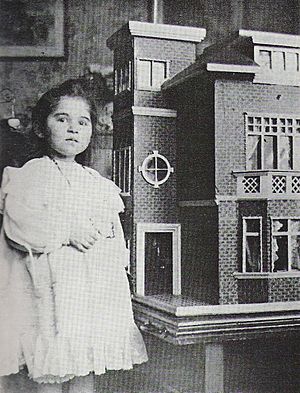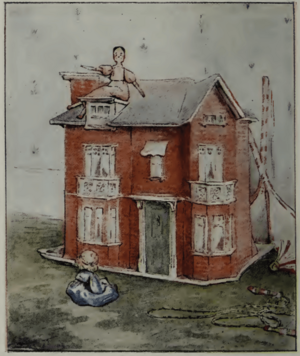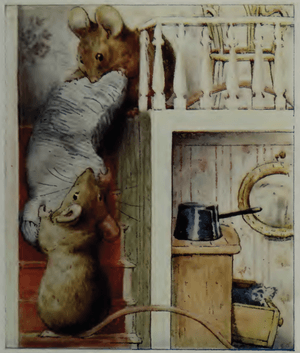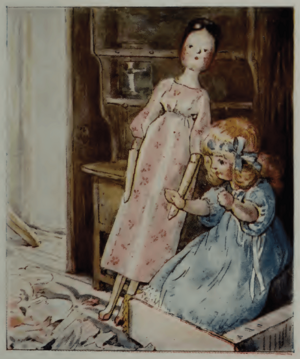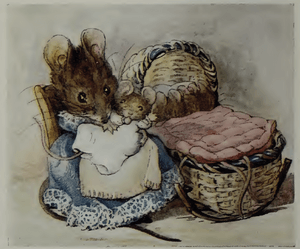The Tale of Two Bad Mice facts for kids
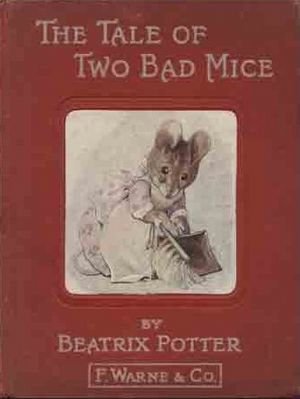
First edition cover
|
|
| Author | Beatrix Potter |
|---|---|
| Illustrator | Beatrix Potter |
| Country | England |
| Language | English |
| Genre | Children's literature |
| Publisher | Frederick Warne & Co. |
|
Publication date
|
September 1904 |
| Media type | Print (hardcover) |
| Preceded by | The Tale of Benjamin Bunny |
| Followed by | The Tale of Mrs. Tiggy-Winkle |
| Text | The Tale of Two Bad Mice at Wikisource |
The Tale of Two Bad Mice is a popular children's book. It was written and illustrated by Beatrix Potter. The book was first published in September 1904 by Frederick Warne & Co. Beatrix Potter got the idea for the story from two real mice. She caught them in a trap at her cousin's house. She also got inspiration from a doll's house. Her editor, Norman Warne, was building it for his niece, Winifred, as a Christmas gift.
The story is about two mice who cause trouble in a doll's house. They find that the food on the dining table is made of plaster. So, they break the dishes and throw the dolls' clothes out the window. They also rip a pillow and take many items back to their mouse-hole. When the little girl who owns the doll's house finds the mess, she puts a policeman doll outside. This is to stop any more damage. The two mice later make up for their actions. They put a crooked coin in the doll's stocking on Christmas Eve. They also sweep the doll's house clean every morning.
The book shows ideas like wanting freedom and being yourself. These ideas reflect Beatrix Potter's own life. She wanted to be independent from her strict parents. She also wanted to create her own home. The book was well-liked by critics. It even brought Potter her first fan letter from America. The story was later made into a part of a 1971 Royal Ballet film. It also became an animated episode in the BBC series The World of Peter Rabbit and Friends. Toys and figures inspired by the tale include Beswick Pottery porcelain figures and Schmid music boxes.
Contents
How the Book Was Made
Getting the Idea for the Story
The idea for The Tale of Two Bad Mice started in June 1903. Beatrix Potter saved two mice from a trap. This was in her cousin Caroline Hutton's kitchen. She named them Tom Thumb and Hunca Munca. These names came from characters in a play. Tom Thumb is not mentioned much after this. But Hunca Munca became Potter's pet. She was a friendly mouse and good at keeping her cage tidy.
In late 1903, Potter wrote three stories. One of these was The Tale of Hunca Munca, or The Tale of Two Bad Mice. Potter hoped one of these stories would be published in 1904. She wanted it to go along with Benjamin Bunny. She wrote to her editor, Norman Warne, about her ideas. She wondered if it was too soon for another mouse book. She had just published The Tailor of Gloucester.
Norman Warne liked the mouse story best. He was building a doll's house for his niece, Winifred Warne. This might have made him favor the mouse tale. Potter wanted to draw the doll's house for her book. But her mother did not want her to visit Warne's family. Potter was upset but continued working on the book.
Creating the Illustrations
In early 1904, Warne sent Potter a special mouse house. It had a glass front and a ladder. This helped her watch and draw the mice easily. Potter also used the doll's house Warne built as a model. She saw it being built and wanted to sketch it.
On February 12, 1904, Potter told Warne she was making good progress. She saw Hunca Munca carrying a doll up the ladder into her nest. She also noticed the mouse did not like the plaster food. Potter said she could finish the book using photographs. On February 18, Warne bought two dolls, Lucinda and Jane, and sent them to Potter. Potter was very happy with them. She also borrowed a policeman doll from Winifred Warne.
Warne sent more items from a toy shop. These included plaster food and tiny furniture. By the end of May, Potter had finished many drawings. The book was published in September 1904. About 20,000 copies were printed. It was dedicated to Winifred Warne, "the girl who had the doll's house."
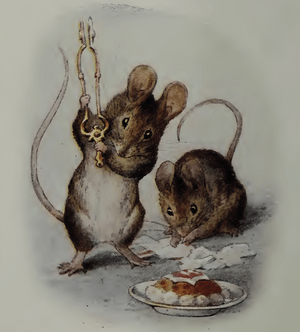
The story shows Potter's happiness in her work and her friendship with Norman Warne. It also shows her joy in playfully breaking rules. The mice cause damage, but it is small and funny. Potter enjoyed creating a story about naughty behavior that she would never do in real life.
Hunca Munca, the real mouse, died in 1905. Potter was very sad. She even made a small doll of her. Later, Potter wrote tiny letters from her book characters to children. In these letters, the mice Tom Thumb and Hunca Munca have nine children. They are still causing a bit of mischief!
The Story of the Bad Mice
The story starts with a "very beautiful doll's-house." It belongs to two dolls named Lucinda and Jane. Jane is a cook-doll, but she never cooks. All the doll's-house food is made of plaster. It was "bought ready-made, in a box." The food looks nice, but it cannot be eaten.
One morning, the dolls leave their house. They go for a ride in their baby carriage. No one is in the nursery. Tom Thumb and Hunca Munca, two mice, peek out from under the floor. They run to the doll's house. They open the door and go inside. They "squeak for joy" when they see the dining table set.
Tom Thumb tries to cut some ham. But it is made of plaster! Hunca Munca says it is "as hard as the hams at the cheesemongers." Tom Thumb smashes it. They try to eat fish, but it is glued to the plate. They realize all the food is fake. So, they smash the lobsters, pears, oranges, and pudding. The fish will not break, so they try to burn it. But the fire is not real.
Tom Thumb climbs up the chimney. Hunca Munca empties the kitchen jars. They are filled with red and blue beads. Tom Thumb takes the dolls' dresses. He throws them out the window. Hunca Munca pulls feathers from the dolls' pillow. She remembers she needs a pillow for her own babies. So, they take the dolls' pillow to their mouse-hole. They also carry off other small things. A cradle fits, but a bird cage and bookcase are too big.
Suddenly, the nursery door opens. The dolls return with the little girl and her governess. Lucinda and Jane are shocked to see the mess. The little girl puts a policeman doll at the front door. But her governess is more practical. She sets a mouse-trap.
The narrator says the mice are not "so very naughty after all." Tom Thumb pays for his actions. He puts a crooked sixpence (a coin) in the doll's stocking on Christmas Eve. Hunca Munca makes up for her part in the mess. She cleans the doll's house every morning. She uses her dust-pan and broom.
Pictures in the Book
The success of The Tale of Two Bad Mice comes from its detailed pictures. Beatrix Potter drew the doll's house very carefully. She drew everything from a mouse's point of view. This made the drawings very accurate. For example, she drew the mice dragging a pillow down the stairs. She imagined herself on the stairs to get the right view. The mice look real and fit the size of the doll's house.
Potter loved drawing the tiny furniture. Her publisher, Warne, even warned her not to put too many details. He thought it might make the pictures too busy. The small size of the book makes the pictures seem even tinier. The borders around the pictures also make the details look smaller.
Main Ideas in the Story
M. Daphne Kutzer, a professor, thinks The Tale of Two Bad Mice is an important book for Potter. It shows her thoughts about home life, work, and social classes. Changes in Potter's life showed up in her art. In 1905, she lost her editor and fiancé, Norman Warne. She also bought Hill Top, a farm that became her home away from London.
Two Bad Mice can be seen as a story with a hidden meaning. Potter shows her wish for her own home. But it also shows her worries about being independent. The book reflects Potter's mixed feelings about wanting freedom and having a home. She wanted to leave her parents' home by marrying Norman Warne. She also wanted to buy her own place.
The story has three main places: the human world, the doll's house, and the mice's home. The book explores ideas about what a home means. It also looks at the joys and dangers of home life. And it shows the ideas of wanting freedom and breaking rules.
The human and doll's house worlds show Potter's own background. The little girl who owns the doll's house has a governess. The doll's house has rooms for servants. It is filled with fancy clocks and flowers. These details show a middle-class home. But Potter is not on the side of the "proper" middle class in this story. She is on the side of the mice who cause trouble. The book is like a small statement of Potter's growing independence. It shows her desire to have her own home. But it also shows her mixed feelings about leaving her parents.
The mice's actions can be seen as a small example of people wanting more freedom. The story suggests that the mice's "repentance" (saying sorry) is not entirely real. Tom Thumb pays for his actions with a useless crooked coin. Hunca Munca cleans a house that was already tidy. Their show of being sorry hides their continued desire for freedom. Potter seems to approve of the mice's wish for a comfortable home of their own. She also shows that the dolls' lives are empty.
Merchandise
Beatrix Potter believed her stories would become classics. She was one of the first authors to sell items based on her characters. She had a Peter Rabbit doll, a board game, and wallpaper. She continued to create similar items for many years.
In 1947, Beswick Pottery was allowed to make porcelain figures of Potter's characters. Seven figures inspired by Two Bad Mice were made between 1951 and 2000. These included Hunca Munca with the Cradle and Tom Thumb.
In 1977, Schmid & Co. started making licensed Beatrix Potter items. They released music boxes in 1981. One had a porcelain figure of Hunca Munca on top. They also made small Christmas ornaments. In 1991, more music boxes were released. They played songs like "Beautiful Dreamer" and "Home! Sweet Home!" and featured the mice.
Translations and New Editions
Beatrix Potter's 23 small books have been translated into almost 30 languages. These include Greek and Russian. The English versions are still published by Frederick Warne & Co. This company was bought by Penguin Books in 1983. In 1985, Penguin started remaking the printing plates for all 23 books. They used new photos of the original drawings. This project was finished in 1987.
The Tale of Peter Rabbit was the first of Potter's books to be translated. It came out in Dutch in 1912. Two Bad Mice was first published in Dutch in 1946. It was also published in German in 1939 and in Japanese in 1971.
Adaptations
The Tale of Two Bad Mice is part of the 1971 Royal Ballet film Tales of Beatrix Potter.
Between 1992 and 1996, many of Beatrix Potter's stories became an animated TV series. It was shown by the BBC and called The World of Peter Rabbit and Friends. One episode combined The Tale of Two Bad Mice with The Tale of Johnny Town-Mouse. In this episode, Hunca Munca was voiced by Felicity Kendal. Tom Thumb was voiced by Rik Mayall. It first aired on June 29, 1994.
See also
 In Spanish: El cuento de los dos malvados ratones para niños
In Spanish: El cuento de los dos malvados ratones para niños


